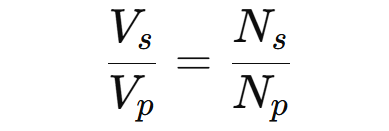Answer:
Inan ideal transformerthe power inputto the primary coil equals the power output from thesecondary coil. In real-world applications, due to minor losses (like core and copper lossestransformers typically operate at 95–99% efficiency.
Example:
If a transformerhas 1000 VA input powerand98%efficiency, the output power will be:
1000 VA × 0.98 = 980 VA.
Answer:
The current increases as voltage decreases, assuming power remains constant. If the secondary voltage is half, the current will double.
Example:
Primary: 240 V @ 2 A → Secondary: 120 V @ 4 A (ideal condition).
Answer:
The turns ratio (number of wire turns on the coils). If the secondary winding has more turns than the primary, it’s a step-up transformer. If it has fewer, it’s a step-down transformer.
Formula:

Answer:

The secondary winding has 3 times as many turns as the primary.
Answer:
Assuming a 97% efficiency,

Answer:
-
Primary winding receives input voltage.
-
Secondary winding delivers the transformed voltage to the load.
Their wire gauge, insulation, and number of turns are designed based on the voltage and current requirements.
Answer:
Secondary voltage tends to drop as load increases due to voltage drop across internal impedance. This phenomenon is measured by voltage regulation.
Answer:
It shows how much the voltage drops under full load compared to no load.
A lower % means better voltage stability.

Answer:
-
Use voltage regulation taps on the transformer.
-
Choose a transformer with low impedance.
-
Employ automatic voltage regulators.
Answer:
-
Core (iron) losses – due to magnetic hysteresis and eddy currents.
-
Copper (I²R) losses – due to resistance in the windings.
Answer:
This implies a step-down transformer with 3 times more turns in the primary.

Answer:
In ideal transformers:

Voltage ratio is directly proportional to turns ratio and inversely proportional to current ratio.
Answer:
Voltage taps adjust the transformer’s output to compensate for high or low input voltage. They help maintain stable output voltage without replacing the unit.
Answer:
-
Voltage transformation (step-up or step-down)
-
Electrical isolation between circuits
-
Impedance matching in communication or audio systems
Answer:
The winding connected to the lower voltage source is the primary winding, even if the output voltage is higher.
Answer:
-
Rated Power (kVA)
-
Input and output voltage levels
-
Frequency (e.g., 50 Hz or 60 Hz)
-
Type (dry-type, oil-immersed, isolation, autotransformer)
Answer:
-
Wye (Y) connection:

- Delta (Δ) connection:

Answer:
A transformer is an electrical device that transfers electrical energy between two or more circuits through electromagnetic induction. It typically works on alternating current (AC) and consists of a core and two or more windings.
Answer:
-
Step-up transformer: Increases voltage.
-
Step-down transformer: Decreases voltage.
-
Isolation transformer: Electrically separates two circuits.
-
Autotransformer: A single winding acts as both primary and secondary.
-
Three-phase transformer: For industrial applications.
-
Dry-type transformer: Air-cooled, safe for indoor use.
-
Oil-immersed transformer: Uses mineral oil for cooling and insulation.
Answer:
-
Single-phase: Used in residential and light commercial applications.
-
Three-phase: Used in industrial and high-power distribution systems. It’s more efficient for large loads.
Answer:
Most power transformers have efficiency between 95% and 99.5%, depending on size and design. Larger units are generally more efficient.
Answer:
Impedance is the opposition to current flow within the transformer due to both resistance and reactance. It’s expressed as a percentage and affects voltage regulation and fault current.
Answer:
Measured in kVA (kilovolt-amperes), it indicates the maximum load a transformer can handle without overheating.
Example: A 75 kVA transformer can support a load of up to 75,000 VA.
Answer:
-
Load Loss (Copper Loss): Happens when the transformer delivers power to a load, due to winding resistance.
-
No-Load Loss (Core Loss): Occurs even without a load, caused by magnetic excitation of the core.
Answer:
Bushings are insulated terminals that allow electrical conductors to pass through the transformer tank while maintaining electrical insulation.
Answer:
It defines the phase difference and configuration of windings in three-phase transformers (e.g., Dyn11, Yyn0). It’s important for paralleling transformers and system compatibility.
Answer:
It accommodates expansion and contraction of transformer oil as temperature changes, helping to maintain proper oil level and pressure.
Answer:
-
Regular oil testing (for oil-immersed units)
-
Checking insulation resistance
-
Thermographic scanning
-
Physical inspection for leaks or overheating
-
Cleaning and tightening terminals
Answer:
No. Transformers only work with AC (Alternating Current) because they rely on changing magnetic fields to induce voltage.
Answer:
A well-maintained transformer can last 25–40 years or more, depending on usage, load, maintenance, and environment.
Answer:
-
Overloading
-
Poor ventilation or cooling
-
Harmonics
-
Faulty connections
-
Deteriorated insulation
Answer:
It adjusts the number of active coil turns to regulate output voltage.
-
Off-load tap changer: Requires de-energization.
-
On-load tap changer (OLTC): Can adjust under load without power interruption.
Answer:
Harmonics are voltage/current waveforms at multiples of the fundamental frequency. They can cause heating, vibration, and noise in transformers.
Answer:
Yes, but conditions must match:
-
Same voltage ratio
-
Same impedance
-
Same polarity
-
Same phase angle and vector group
Answer:
-
Power distribution (utility transformers)
-
Industrial machinery
-
Renewable energy systems (solar, wind)
-
Medical equipment (isolation transformers)
-
HVAC systems
-
Marine and oil platforms
-
Commercial buildings
Answer:
-
Use appropriate PPE (Personal Protective Equipment)
-
De-energize before maintenance
-
Follow grounding protocols
-
Respect clearance distances
-
Check for oil leaks and hotspots
Answer:
-
CE (Europe)
-
UL/CSA (North America)
-
GOST (Russia/CIS)
-
ISO 9001 / ISO 14001
-
Type test reports (short-circuit, temperature rise, lightning impulse)
Answer:
Grounding provides a path for fault currents and enhances system safety. It also prevents overvoltages caused by lightning or switching surges.
Answer:
Because transformers supply both active (kW) and reactive (kVAR) power. They are not affected by the load power factor, so kVA reflects total capacity more accurately.

